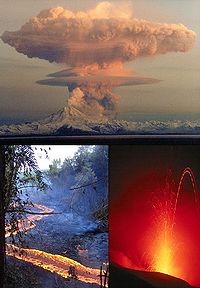
Photo from wikipedia
Abstract Previously reported whole-rock δ18O values (5.6–7.8‰) for primitive quaternary mafic lavas from the southernmost Cascades (SMC) are often elevated (up to 1‰) relative to δ18O values expected for mafic… Click to show full abstract
Abstract Previously reported whole-rock δ18O values (5.6–7.8‰) for primitive quaternary mafic lavas from the southernmost Cascades (SMC) are often elevated (up to 1‰) relative to δ18O values expected for mafic magmas in equilibrium with mantle peridotite. Olivine, clinopyroxene, and plagioclase crystals were separated from 29 geochemically well-characterized mafic lavas for δ18O measurements by laser fluorination to assess modification of the mantle sources by ancient and modern subducted components. Oxygen isotope values of olivine phenocrysts in calc-alkaline lavas and contemporaneous high alumina olivine tholeiitic (HAOT) lavas generally exceed depleted mantle olivine values (~4.9–5.3‰). Modern addition of up to 6 wt% slab-derived fluid from Gorda serpentinized peridotite dehydration (~15‰) or chlorite dehydration (~10‰) within the serpentinized peridotite can provide the 18O enrichment detected in olivine phenocrysts (δ18Oolivine = 5.3–6.3‰) in calc-alkaline mafic lavas, and elevate 18O in overlying mantle lithosphere, as well. Specifically, although HAOT δ18Oolivine values (5.5–5.7‰) may refect partial melting in heterogeneous 18O enriched mantle source domains that developed during multiple subduction events associated with terrane accretion (e.g., <1 wt% of ~15‰ materials), an additional 18O enrichment of up to 2 wt% of 10–15‰ slab-derived hydrous fluids might be accommodated. The calc-alkaline primitive magmas appear to have experienced a continuous range of open system processes, which operate in the mantle and during rapid magma ascent to eruption, and occasionally post quench. Textural relationships and geochemistry of these lava samples are consistent with blends of mafic phenocrysts and degassed melts in varying states of 18O disequilibrium. In lenses of accumulated melt within peridotite near the base of the crust, coexisting olivine and clinopyroxene δ18O values probably are not at isotopic equilibrium because fluids introduced into the system perturbed the δ18Omelt values. A “sudden” melt extraction event interrupts 18O equilibration in phenocrysts and poorly mixed melt(s). Rapid ascent of volatile oversaturated primitive mafic magma through the crust appears to be accompanied by devolatilization and crystallization of anorthite-rich plagioclase with elevated δ18Oplag values. The (Sr/P)N values for the whole rock geochemistry are consistent with a 87Sr/86Sr ~0.7027 slab-derived fluid addition into the infertile peridotite source of magmas, and melt devolatilization is recorded in the mixture of disequilibrium δ18O values for the constituent phases of lavas. Morbidity of the Gorda Plate as it undergoes intense deformation from the spreading ridge to the trench is likely a key factor to developing the carrying capacity of hydrous fluids and mineral phases in the slab subducting into the SMC mantle.
Journal Title: American Mineralogist
Year Published: 2017
Link to full text (if available)
Share on Social Media: Sign Up to like & get
recommendations!